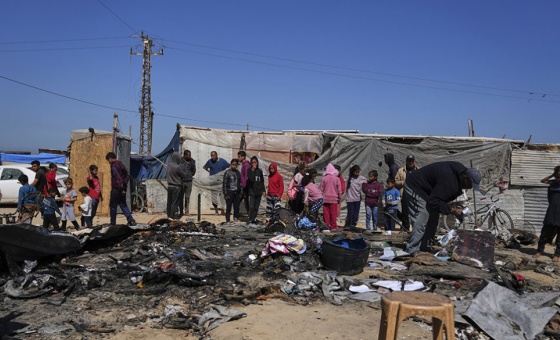“TOMMY ROBINSON” is easy to brush off as a somewhat ridiculous, if thoroughly detestable, figure. Now masquerading as a “journalist,” he has had various incarnations in his role as poster boy for the far right.
What can’t and shouldn’t be easily brushed off is the risk the far right continues to pose in Britain, across Europe and around the world.
The far right has been struggling to reorganise in recent years, although capitalising well at times off certain high profile news stories.
Thousands gathering in London for a far-right march over the weekend under Robinson’s banner, chanting openly Islamophobic and racist slogans, shows however the potential that remains and could quickly reassert itself if the left and labour movement fail to reassess our strategy, tactics and outlook in combatting the far right — especially since Establishment parties, so quick to shout “hate march” when people mobilise for peace, have been very quiet about an actual hate march promoting poisonous lies, such as that London has been turned into “Londonistan” under a Muslim mayor.
It’s not just in Britain that we are seeing a resurgence of the far right.
In Europe — as has been covered extensively in this paper — the far right has been capitalising on widespread popular discontentment with EU policies (and a failure of the left to challenge them) — from Hungary and Sweden to Italy and Portugal.
We often, quite correctly, say that capitalist crisis is the opportunity for the left to make gains, to raise class consciousness and to achieve a revolution. But it is also a dangerous moment where capitalism moves to deploy more fully some of the most potent weapons in its arsenal — racism and xenophobia, and even fascism itself where the system is under existential threat.
Capitalism is only able to sustain itself by divide-and-rule tactics, breaking up working people along lines of race and sex — and any other lines it can easily draw which distract from the fundamental divide: class.
Blaming migrants or ethnic minorities is a well-tested and favourite way to divert popular anger away from the system itself.
Migrants and minorities, by virtue of their oppressed status and place in society, can also be super-exploited, paid poverty wages for working in the worst of conditions.
Imperialist war and oppression are the source of the forced migration and refugee crises we are seeing across the world.
It is a cruel and cynical reality that the same monopoly media newspapers that pump out anti-immigrant sentiment are owned and controlled by the same financial interests that super-exploit the same migrant labour they condemn.
While the far right here in Britain remains small and disorganised for the moment, not least due to the efforts of anti-fascists across Britain, it remains a potential weapon that can be picked up and wielded by the ruling class at any time.
Whether the left and the labour movement are fully prepared for such an eventuality is open to question — the march went ahead last weekend.
The left has to reassess how we deal with the far right and combat the ever-present threat.
A community focus is key, campaigns like those which were conducted in Erskine in Scotland opposing far-right efforts to latch on to asylum-seeker hotel accommodation hold important lessons.
Working people lacking class consciousness may have legitimate concerns about the impact of immigration on public services and jobs. The role of the left isn’t to immediately denounce them as irredeemable Nazis.
Such an approach is likely to drive them into the arms of the predatory groups we’re opposing.
We have to be active and present in communities in order to have the credibility to combat the underlying narratives, to point the blame squarely at the capitalist system and to be clear only socialism can solve the crisis capitalism has created and forever end the threat of the far right.







